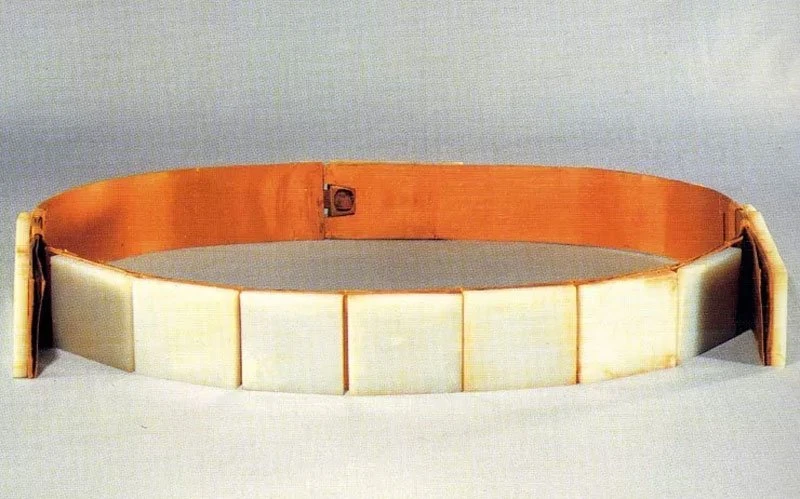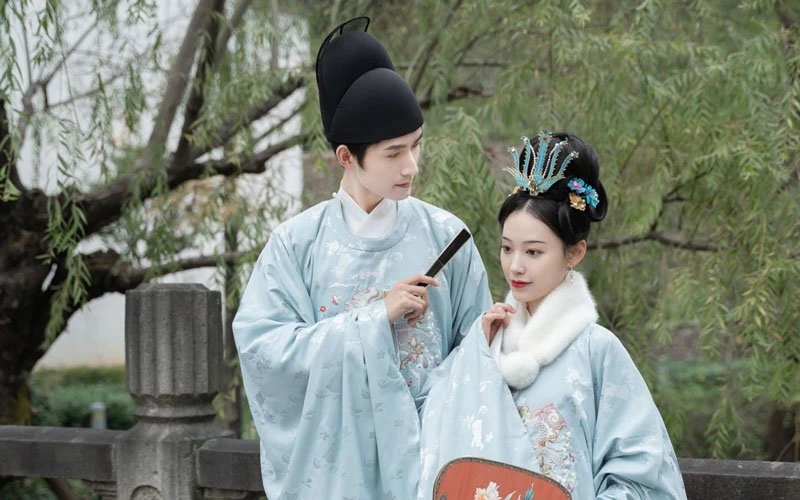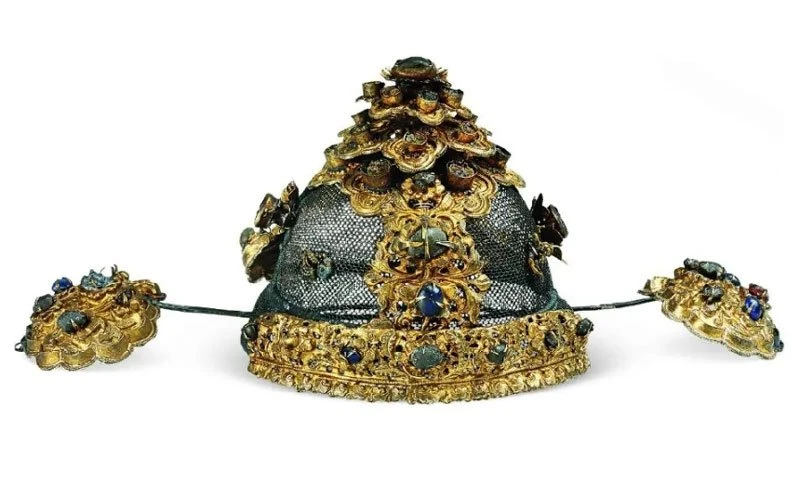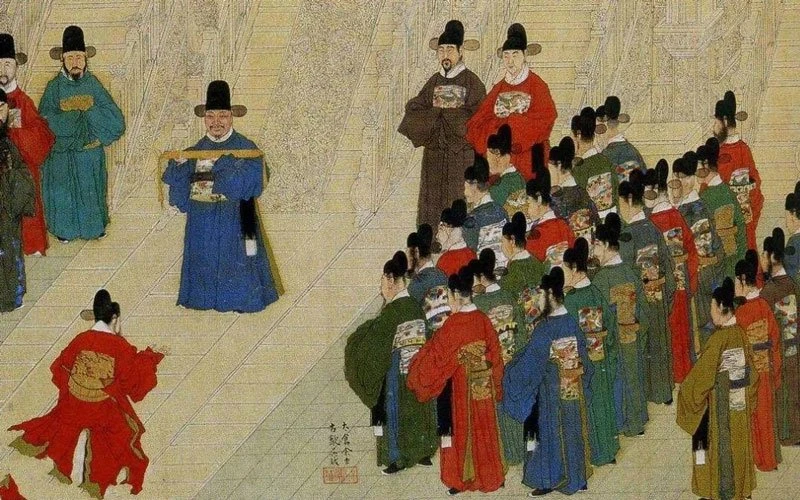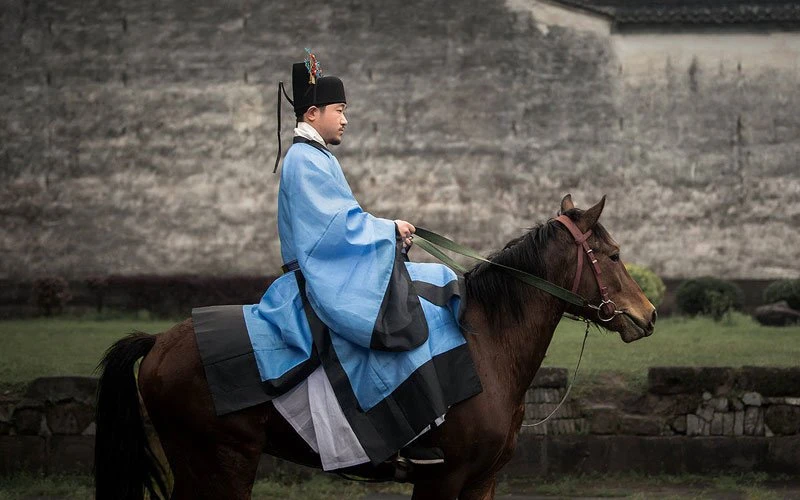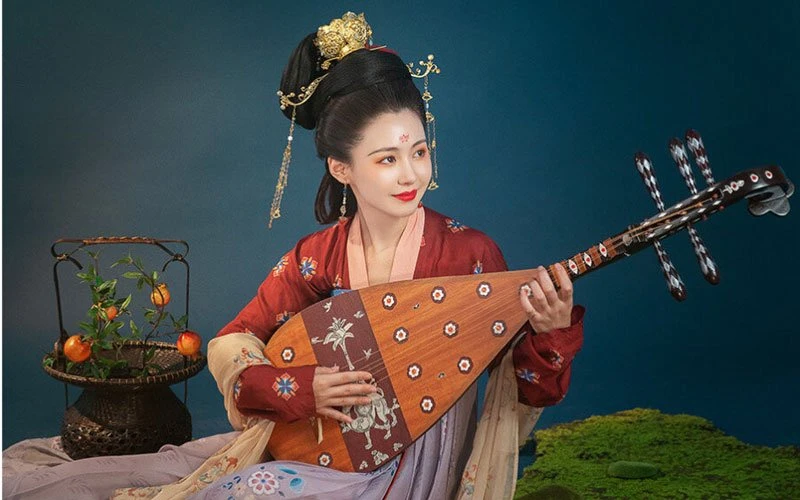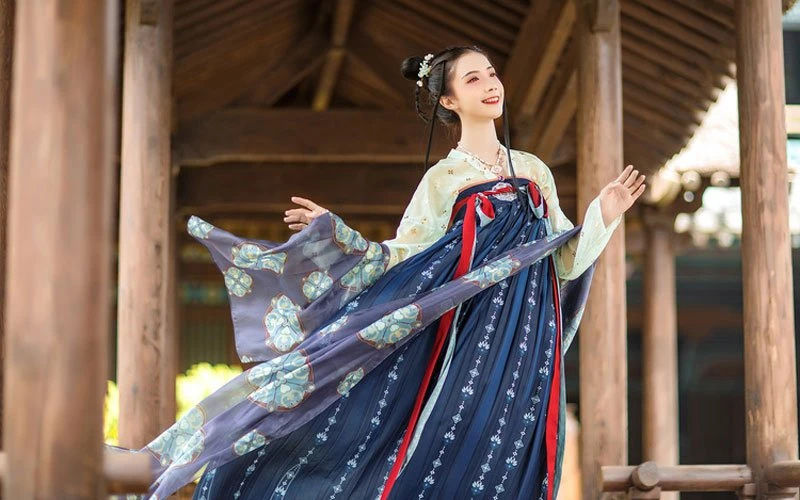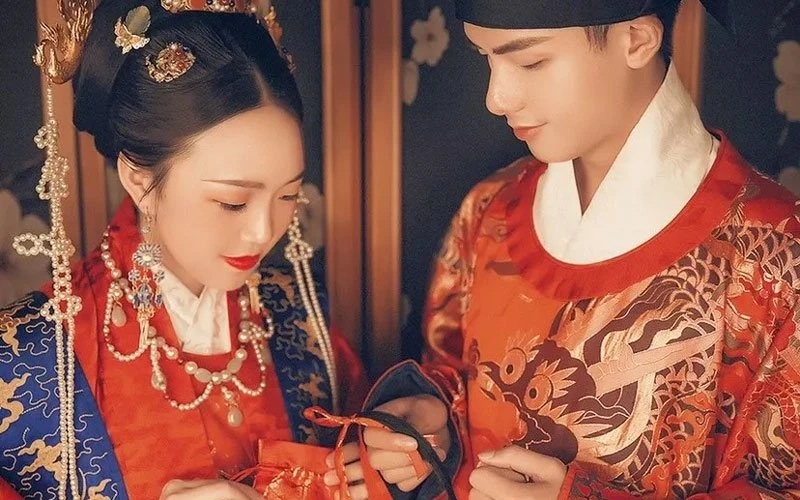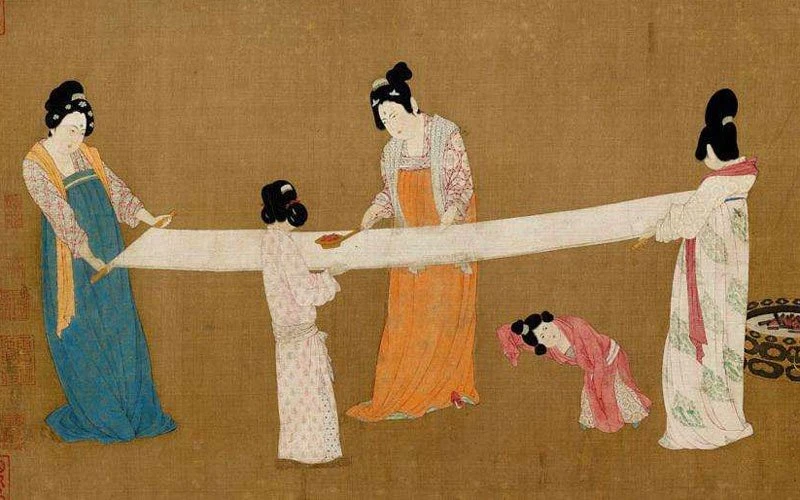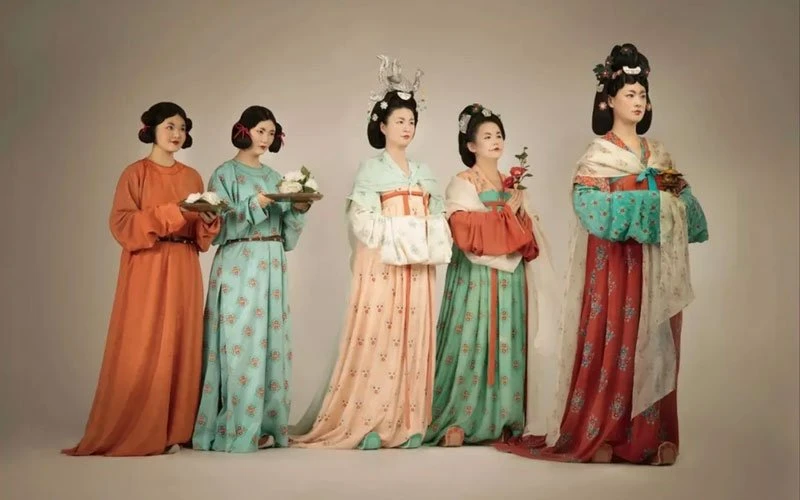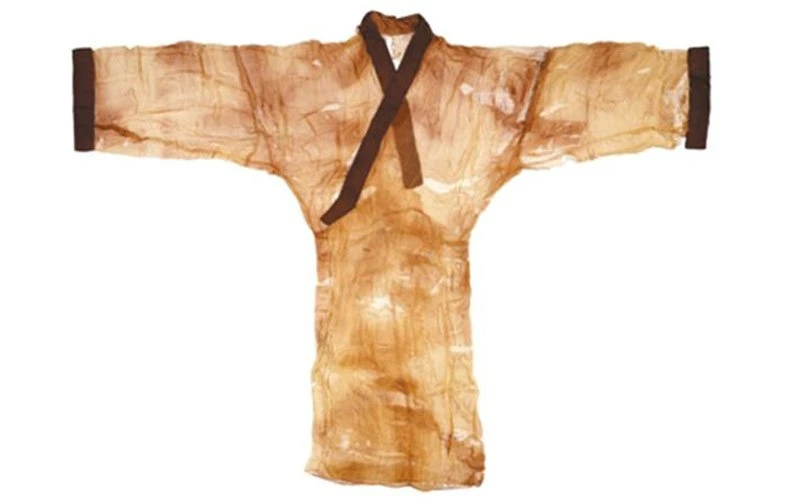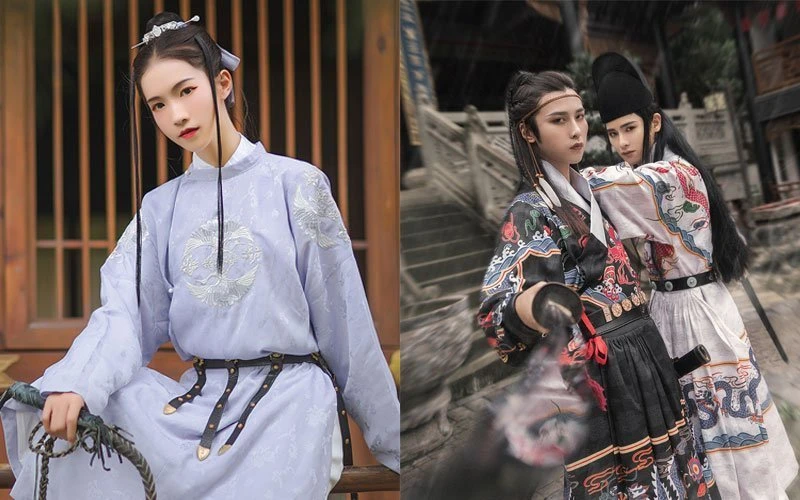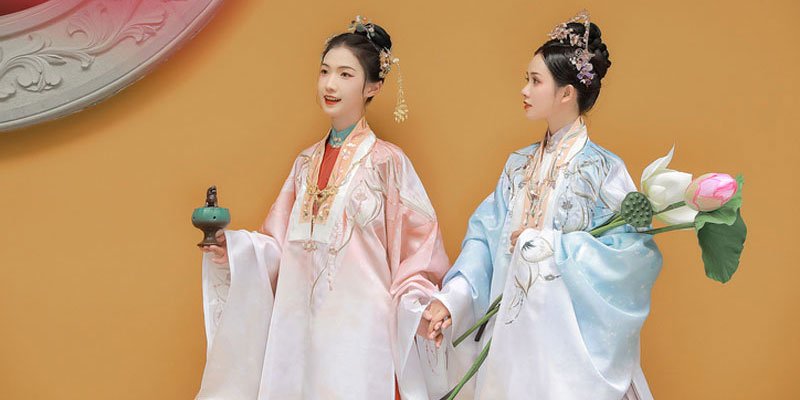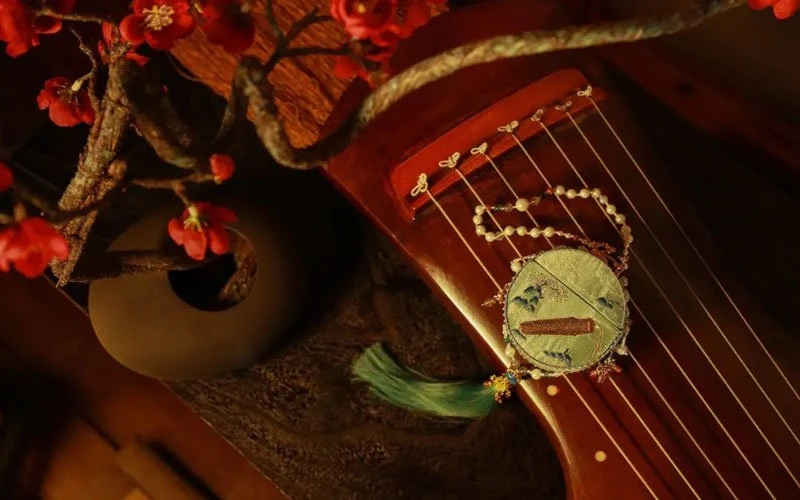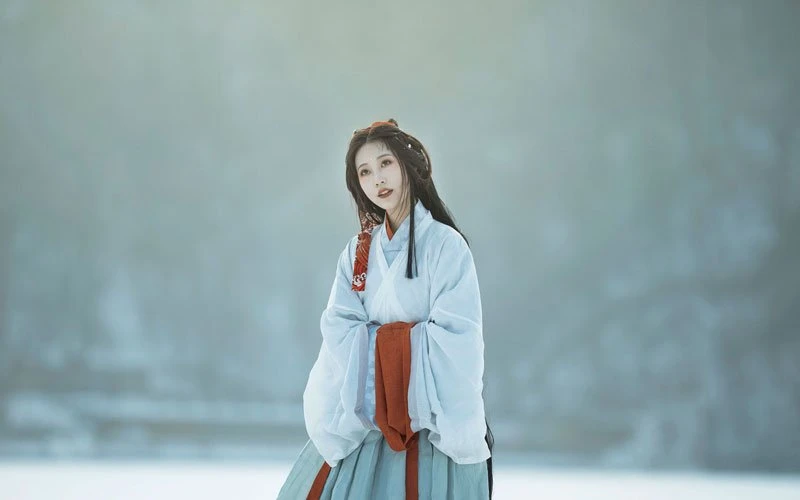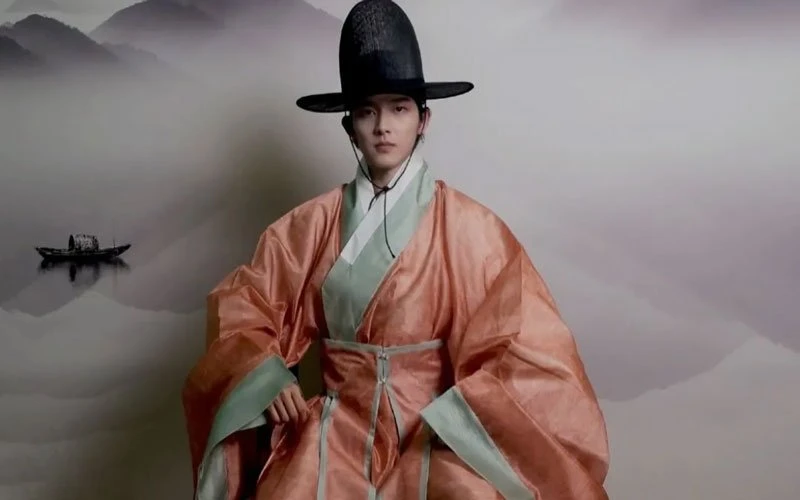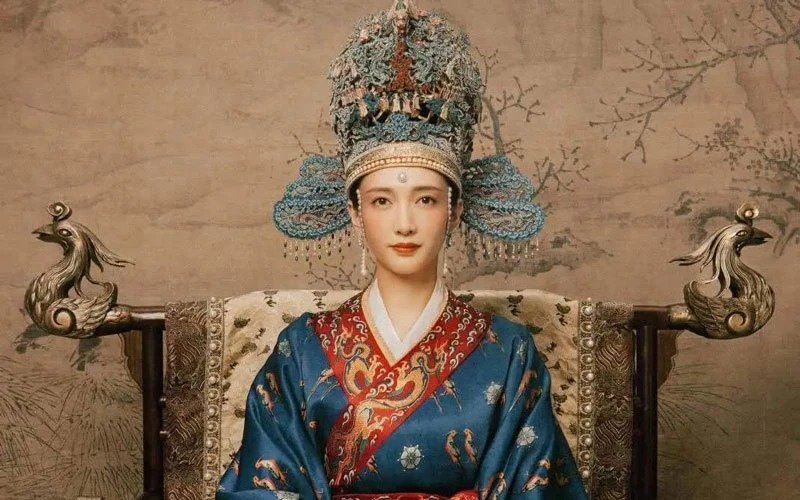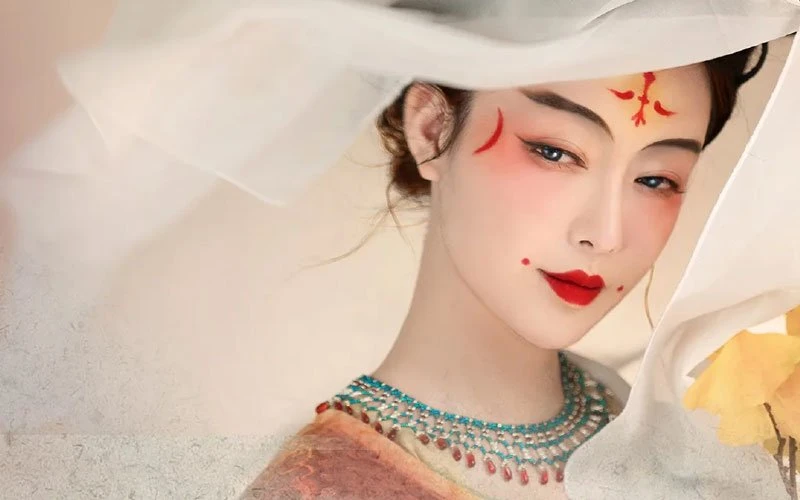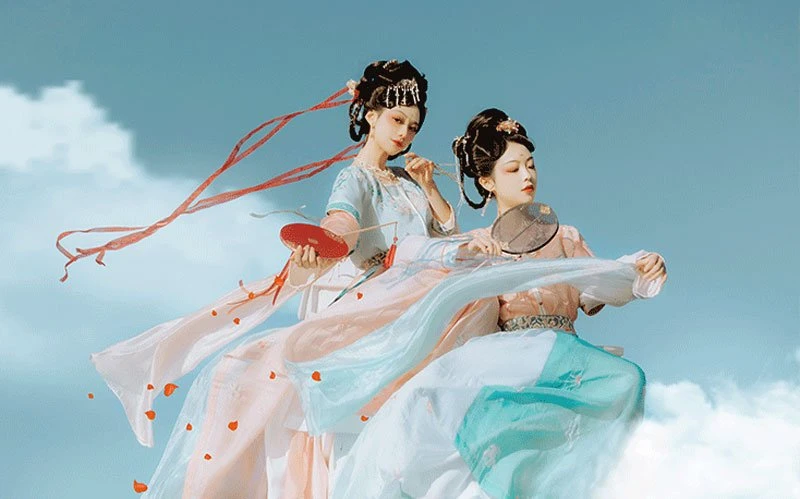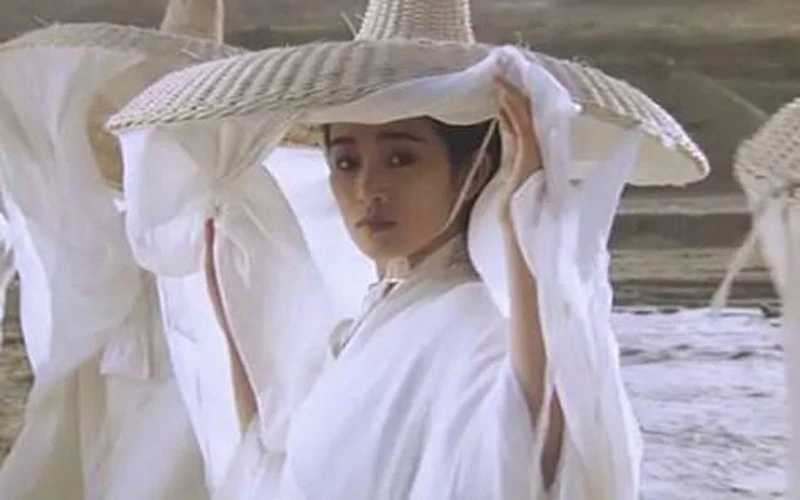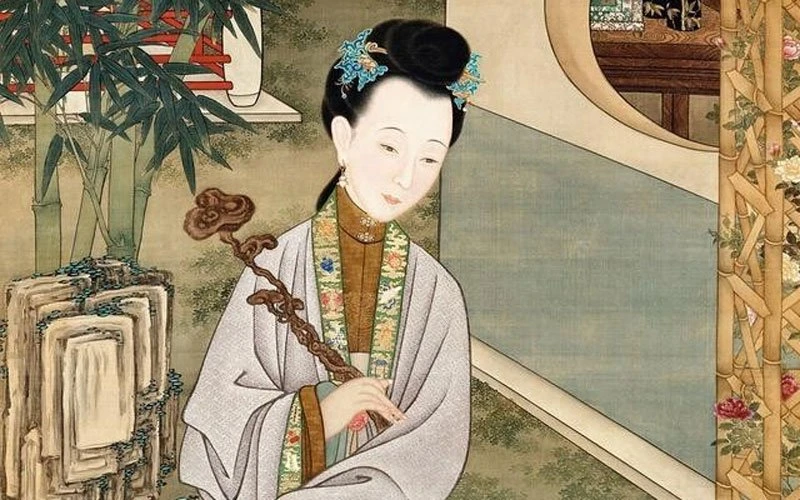-
The Most Classic Hanfu of All Time
In the process of evolution, there are dozens or even hundreds of styles of Chinese clothes. This article mainly introduces the most classical styles of Chinese Hanfu clothes. Women's clothing Suit Ruqun(襦裙) Ruqun is a kind of hanfu, also call: Shanqun (衫裙), short clothes worn on the upper body, call "Ru", and the dress of the lower body, call "Qun", together call "Ruqun". It is a typical "Shangyi Xiachang(top clothes and underdress) " form. Ruqun has an obvious feature: short top and long dress. The Ruqun appeared in the Warring States Period, Ruqun was worn by ordinary people(female) until the end of the Ming and Qing Dynasties. Jiaoling Ruqun/ Shanqun(交领襦裙/衫裙) Jiaoling Ruqun is a kind of Ruqun, the main feature is: the top collar is cross. It is quite common in the Song Dynasty. Wearing method: First: Wear top clothes, Align the collar of the top clothes; Tie a knot in right Jin(襟, the chest part of the top); Tie a knot in left Jin. Second: tie up the dress, Put the dress in front of you, wrap the skirt behind you; Two sides of the dress overlap behind; Folding outwards the pressing on the inner layer of dress;…- 9
- 10
- 21.3k
-
History of Hanfu Sash & Belt Ornament in Ancient China
In the ancient Chinese costume system, Hanfu sash and belt ornaments played a very important role, not only as a means of securing and decorating the garment, but also as a symbol of the wearer's status. In ancient times, officials wore Chaofu (朝服) when going to Shangchao (上朝). The Chaofu was the ancient official's uniform for political discussions, one of the important functions of Chaofu in ancient China was to distinguish between the ranks of superior and inferior through clothing. This distinction was mainly made through the three aspects of the Guan (冠, headwear), the color/Zhangwen (章纹) of the garment, and the belt ornaments. The belt ornaments on Chaofu, specifically the belt and the various types of pendant hanging from it, are mainly of the following types: jade pendants, Bixi (蔽膝), Yinshou (印绶), and Yufu/Yudai (鱼符/鱼袋). In ancient Chinese Chaofu, belt ornaments were a very important part, especially for men, as they were almost the only ornaments they wore and were important identity markers. The role of the belt ornament in expressing the wearer's rank was clearly and straightforwardly defined in the costume system during the Zhou dynasty, and was later enriched and refined through the ages. Hanfu Belt for…- 3
- 4
- 5.2k
-
What is Chinese Headdress - Hanfu Traditional Hats Introduce
A complete set of Hanfu includes Shoufu (首服, hanfu headdress), Tiyi (体衣, hanfu clothes), Zuyi (足衣, hanfu shoes and socks) and accessories. Let's talk about the Chinese headdress today. Chinese headdress brief introduction The Chinese headdress is one of the important parts of ancient Chinese clothing, In ancient times, both men and women of Han nationality coiled their hair into a bun and fixed it on their heads with a hairpin. The main Chinese headdress is Guan (冠, crown, a hat that goes with a formal dress in ancient), Mao (帽, hats), Jin(巾, kerchief), etc. Mao mainly includes gauze hat (纱帽), hood (风帽)and Jin mainly has the black silk ribbon scarf (纶巾), the net kerchief (网巾) and so on. When the Yellow Emperor invented the Guan, the rite of adulthood of the Han nationality - the rite of male Guanli (冠礼) and the rite of female Jili (笄礼) - shows that Shoufu plays an important role in the national cultural psychology. Since the Qin Dynasty, there has been no separation of Yi and Guan (clothes and hats). However, due to the feudal concept, the number of women in the civilian class wearing the Guan is very small. Many years later, in…- 0
- 2
- 14k
-
Top 5 Styles of Traditional Chinese Dress & Clothing
The story of clothing and costumes is one of the most fascinating developments in human history. Traditional Chinese Dress & Clothing has a long history and cultural content, and it is an important part of Chinese excellent cultural heritage, so It has particular researching value. https://www.youtube.com/watch?v=YaD4vS2GQxw Every nation in the world has its unique traditional clothing. The particular histories and cultures could be recognized so as for people to distinguish one citizen from another. China, as a multi-ethnic and time-honored country, has many ethnic minorities who have their indigenous culture. The mutual influences among these different cultures have contributed to the rich textures and fabrics of history and have made Chinese clothing with great variation and glory. Traditional Chinese dress & clothing has been shaped and developed alongside the interactive influences between the outside world and China’s own dynastic traditions. Every different dynastic has different scopes of territory, social values, social norms, etc. Therefore, many aesthetic standards were made according to the environments (socially, geographically, economically, politically) of certain dynastic. This is the main reason why traditional Chinese clothing has such many styles. 5 Types of Traditional Chinese Clothing & Dress For exploring the world of traditional Chinese clothing, it is necessary…- 12
- 11
- 35k
-
Traditional Chinese Hair Jewelry - Ming Style Diji & Tiaopai
Diji and Tiaopai are two magnificent pieces of traditional Chinese hair jewelry, often paired with Ming-style Hanfu. The Ming dynasty was one of the most commercialized periods in ancient Chinese history, particularly in the Jiangnan region. From the point of view of hair jewelry, the most significant change shown in gold and silver jewelry during the Ming dynasty, compared to the Song and Yuan dynasties, was an increase in the number of types and styles, and a more detailed distinction in names. Various types of traditional Chinese hair jewelry, have different names, depending on where they are worn, or on their decoration, style, and even their length. Today we will focus on the Diji and Tiaopai. Diji (䯼髻, dí jì) [History and structure] Diji is a new type of wig bun that appeared in the Ming Dynasty, generally made of gold and silver wire or horsehair, and hair, covered with soap-colored yarn and worn over the top bun. The appearance of the Diji was influenced on the one hand by the wearing of Guan by women from the Northern Song Dynasty onwards, and on the other by the popularity of the 'Baoji (包髻)' hairstyle during the Jin and Yuan Dynasties.…- 1
- 3
- 1.6k
-
The Development of Chaofu in Ancient China
We often see in Chinese TV dramas or movies scenes of the emperor and his ministers discussing political affairs together (called Shangchao, 上朝), with the ministers standing or kneeling opposite the emperor in order of rank, dressed in tidy clothes (Chaofu). So, what is so special about the ministers' clothing? And are the different eras of Chaofu the same? What is the Chaofu? Name: Chaofu (朝服, cháo fú) Alias: Jufu (具服) Function: used at major ceremonies Succession and change: from Zhou to Ming dynasties Before the Zhou Dynasty, Chinese clothing was mainly made in one form, the upper Yi (衣) and the lower Chang (裳) system. The Book of Rites - Yuzao (礼记·玉藻, a chapter describing the ritual) recorded that "Chao Xuanduan (玄端), Xi Shenyi (深衣)", meaning that ministers were required to wear Xuanduan in the morning to attend the Shangchao, while worn Shenyi at home in the evening. The style and development of Chaofu in different dynasties The earliest Chaofu - Pibian Fu Judging from the literature, there were Chaofu as early as in the Zhou Dynasty. The first Chaofu was the Pibian Fu (皮弁服, pí biàn fú), which was made of fine white cloth, and the Yi and… -
Chinese Traditional Costume - Lanshan for Scholars
Have you've ever wondered what an ancient Chinese scholarly person's costume looked like? In this issue, let's follow Hanfu Culture Society and take a look at one of the Chinese traditional costumes, Lanshan (襕衫, lán shān), a Hanfu costume made especially for scholars. [Structure and History] In the history of ancient Chinese traditional costume, there is a kind of long garment that is cut in one piece at the top and bottom (Tongcai, 通裁) and has a Hanglan (横襕, a seam at the Lanshan's knee) at the hem, which is called "Lanshan". Lanshan is based on the ancient Shenyi Zhi (深衣制), with the Shenyi waistline moved down to the hem, and Henglan added near the knee. The system of the upper Yi and lower Chang was followed in ancient times, and the ritual system was made to symbolize the ancient people's respect for the world and the construction of order. Lanshan began to appear in the Northern dynasty and developed and became more standardized in the Tang dynasty. During the Tang Dynasty, it absorbed the northern dynasty costume system and changed the collar shape from cross collar to round collar and the sleeve style from big sleeves to narrow sleeves.…- 1
- 1
- 2.1k
-
History of Traditional Chinese Hair Accessories
As the old saying goes, "Men are willing to die for those who appreciate them, and women are willing to makeup for those who appreciate them". From ancient times to the present, women have always been the trendsetters in the pursuit of beauty. From Chinese traditional clothing to Hanfu makeup to various accessories, each item has passed through history and left a strong mark in the history of women's lives, becoming a classic art appreciation. Previous articles on traditional Chinese earrings have already done some telling about women's earrings and their culture from ancient times to the present, but today we're going to talk about the history of another type of ornaments - traditional Chinese hair accessories. Derivation of the traditional Chinese hair accessories In ancient China, Confucianism was the orthodox idea of the society, emphasizing "ritual". Hair, as part of the body, is considered unclean and rude if it is disheveled. Therefore, men at the age of 15 years need to tie the hair as a bun, women at the age of 15 years need tie hair as a bun and wear Ji (笄), already a kind of "ritual" custom in ancient time. As to when the custom…- 7
- 4
- 14.6k
-
History of Chinese Traditional Hanfu Shawl: Pibo
Pibo (披帛, pī bó), traditional Hanfu shawl, made from light fabric silk, although now the Hanfu enthusiasts accustomed to call it Pibo, but the name "Pibo" actually appeared later, about the late Tang Dynasty, more often it is called Pei (帔, pèi). In earlier Chinese dramas, Pei was once the symbol of "Chinese ancient costume" with its elegant and beautiful features. In the wardrobe of ancient women, Pei has always been very distinctive and not to be ignored part, wrapped between the arms or draped over the shoulders and neck. Also in Chinese wedding customs, there is "Fengguan Xiapei (凤冠霞帔)", different eras of Pei also have different styles. So how has Pei changed over its long history, and what role has it played? Follow along with Dongfang Zhuangdao to find out more. Traditional Hanfu Shawl Pei before the Song Dynasty Pei, a long silk shawl worn by women in ancient times, is thought to have originated during the Qin and Han dynasties, the more accepted theory is that it was influenced by Buddhism and Metaphysics and originated from the Dajin (搭巾) worn by figures in statues. Since the beginning of the Northern and Southern Dynasties, in the context of ethnic…- 2
- 3
- 3.8k
-
Introduction of Chinese Traditional Hanfu Wedding
Hanfu wedding, which is wearing traditional Chinese clothing: Hanfu, and taking the traditional Chinese wedding system as the prototype. Modern people restore the traditional Chinese wedding, they roughly sum it up as follows The Zhou Hanfu wedding (周制婚礼), represented by the pre-Qin and Han Dynasties. Tang Hanfu wedding (唐制婚礼) represented by Wei, Jin, and Tang Dynasties. Ming Hanfu wedding (明制婚礼) represented by song and Ming Dynasties. The traditional Chinese Hanfu wedding ceremony is generally divided into three parts: pre-wedding ceremony, formal wedding ceremony, and post-wedding ceremony. As we all know, culture is the life of a nation, and etiquette is one of the main signs of all civilized nations and an important window of national culture. As the Chinese nation with a long civilization of 5000 years, attach great importance to marriage. The book of Zhouyi said: Only when there are heaven and earth can there be everything. Only when there is everything can there be men and women. Only when there are men and women can there be couples. Only when there are couples can there be fathers and sons. Only when there are fathers and sons can there be princes and ministers. Only when there are princes and…- 1
- 3
- 3.2k
-
How did the Ancients Chinese Iron Hanfu
Iron is a common small appliance in modern homes, and almost every home has one, but did you know that irons have been in use since 2000 years ago, or even earlier? How did the ancients iron Hanfu? The Origin of the Ancient Iron The origin of the name "Yundou (熨斗, iron)" is that its image is similar to that of "Big Dipper", and secondly, the shape of the Yundou is like the China ancient cooking utensil "Dou (斗)". In ancient China, the Yundou, also known as "fire Dou", "gold Dou (an iron made of gilding technology, it is not a general folk good)", "Gumu (钴鉧)", its main function is to iron Hanfu clothes, the effect is two: one is to iron out any wrinkled areas of clothing, another effect is to iron the pleats, at where need to be visibly pleated. The first iron was made of stones, pottery, or copper, roasting on the fire, and then pressed on the clothes to iron them. It is said that iron was invented before the end of the Shang Dynasty. King Zhou of the Shang Dynasty was inspired by the fact that irons burned people's hands when they were used,…- 0
- 1
- 975
-
Types and Wear Styles of Tang Dynasty Women’s Clothing
Ordinary Tang dynasty women's clothing we are all familiar with, a short blouse, a long skirt, and then shawls, which is often referred to as "Tang Ru", "high-waisted Ruqun" or "shawls Ruqun". And so on with this set of clothing. But what exactly were these garments called in ancient times, and what were the specific wearing sequence? Let's take a look. The basic equipment of daily women's clothing in the Tang Dynasty is: shirt, skirt, and shawls. In addition, depending on the situation, they also included a Beizi, Mofu (陌腹, underwear), shoes and socks, etc. The following is a description of the types of Tang Dynasty women's clothing for daily and the way to match in the four seasons. Shanzi (衫子, shān zi, shirt) · Ru (襦,rú) Women in the Tang dynasty wore long-sleeved blouses with narrow sleeves and short bodies, now generally called "Ru (襦)", but according to Tang custom it should be called "Shanzi". Various Tang dynasty documents, unearthed clothing records and poetry novels in the costume vocabulary, mention of daily women's clothing, from the early to mid-to-late Tang dynasty, almost all the tops are "Shanzi". Shanzi were very short in length, mostly less than the waist, and…- 4
- 3
- 10.8k
-
History of Chinese Silk Robe & Han Dynasty Textile Industry
Silk is one of the symbols of Chinese civilization, China due to the abundance of silk, has been named the "Silk Country" known, the use of silk is also with the development of the times are also changing, from the initial production of clothing, to later become a popular commodity and to some extent, instead of currency, all of these changes have highlighted its unique status. Today begins through a precious Chinese silk robe, discover how the Han dynasty textile industry developed in ancient China. Precious Chinese silk robe: Sucha Danyi In the winter of 1951, while conducting archaeological work in Changsha, archaeologists discovered two connected grave at Wulipai in the eastern suburbs of Changsha. After several difficult excavations until 1974, the Mawangdui Han tombs, which had been dormant for thousands of years, was unveiled. Among the many precious artifacts unearthed, the most notable is the Zhiju Susha Danyi (直裾素纱襌衣, plain yarn garment). "Thin as a cicada's wing, light as floating smoke", this Chinese silk robe was especially valuable because it was 128cm long, with 190cm sleeves, but weighed a mere 49 grams and could even fit in a matchbox when folded. It was hailed by archaeologists as a milestone…- 1
- 2
- 1.8k
-
Hanfu History | The Development of Chinese Robe System
We often see many different Chinese robe styles of Hanfu, but you may not be able to say exactly what the difference is between them. There are many similarities in different styles of Hanfu, but with the development of history, it is gradually optimized, convenient to wear, and also derived from different shapes. This article will introduce the form system of the Hanfu and Chinese robe system. The form system of Hanfu There are many styles of Hanfu, but they can be divided into the following shapes, Yichang system (衣裳制), is the kind with the separation of the upper and the lower garments. Shenyi system (深衣制), is the one-piece kind that unites the upper and the lower garments together, make separately, and sew together. Paofu system (Chinese robe, 袍服制), cut out the upper and the lower garments with a piece of cloth, no seam in the middle, natural integration. The uniform system of Chinese robe (袍服) Chinese robes appeared in the pre-Qin period, at that time, were just underwear with cotton, so people have to wear it with their coats. In the Zhou Dynasty, emperors used robes for daily wear. In the Qin and Han Dynasties, the status of robe…- 5
- 4
- 9.1k
-
Guide to Traditional Chinese Clothing - Hanfu
Hanfu (汉服, hàn fú), Chinese traditional costume, the full name of which is "traditional costume of Han nationality". It is also known as Han Yiguan(汉衣冠), Han Zhuang (汉装), and Huafu (华服), which was formed from the reign of the Yellow Emperor to the middle of the 17th century (late Ming and early Qing dynasties), in the main residential areas of the Han nationality, with "Huaxia-Han" culture as the background and the dominant idea. With the Chinese ceremonial culture as the center, through natural evolution, formed the unique style and character of the Han nationality, obviously different from the traditional clothing and accessories system of other nationalities. This guide is classified according to the 1: basic feature of the Hanfu, 2: Hanfu shape & style, 3: Hanfu in different wearing scenes, 4: Hanfu in different dynasties, and the 5: related contents of Hanfu, so as to facilitate readers to understand and query. Basic Feature of the Hanfu 1.1: Basic Structure Hanfu is cut from 50cm wide cloth and divided into parts: Ling (领, lǐng, collar), Jin(襟, jīn, placket), Ren (衽, rèn, overlapping part), Jin (衿, jīn or jìn), Ju (裾, jū), Xiu (袖, xiù, sleeves), Mei (袂, mèi), Dai (带, dài,…- 16
- 7
- 28.8k
-
The History of Chinese Traditional Scented Sachet
Chinese incense culture has a long history. As an important part of incense culture - Chinese traditional scented sachet culture, it also carries a large amount of cultural information, reflecting the aesthetic concepts and social customs of people in different periods, as well as the achievements of Chinese textiles and fine manufacturing. Nowadays, due to the emergence and use of aromatherapy, perfume, and other items, incense sachets have rarely been used except on specific festivals and occasions, but they have left a strong mark in the history of incense used in China. The History of the Traditional Sachet Scented sachet (香囊, Xiangnang) is a folk embroidered craft created by ancient women, originally developed from Peinang (佩囊), a small cloth pocket used by the ancients to hold small objects. There were no pockets on the clothes of the ancients, so some portable necessities, such as seals, hand towels, coins, etc., were stored in this kind of pouch, and when they went out, they put it on their waist, so it was called "Peinang". Scented sachet belongs to a kind of Peinang, which is named after the spices stored in the sac. According to the literature, the history of wearing scented… -
Chinese Historical fashion Items for Tang Dynasty Women
As we all know, the Tang Dynasty had unprecedented national power, strong economic strength, people lived in peace and happiness, and the people's pursuit of fashion is also increasing. Today for you to introduce the women fashion items in the Tang Dynasty, let's take a look at Chinese historical fashion together. The Essential Diexie Belt (蹀躞带) for Tang Dynasty Women The movie "The Assassin" released in 2015, in which the female protagonist Nie Yinniang is dressed in a black robe, wearing a very fashionable belt at the waist, which is a popular "Diexie belt" in the Tang Dynasty. Diexie belt was originally a kind of waist belt of the Hu people, since the Wei and Jin Dynasty, introduced into the Central Plains, to the Tang Dynasty was once set as civil and military officials must wear something. An antique Tang dynasty Diexie belt, now in the Shaanxi Provincial Institute of Archaeology. It is 1.5 meters long and 1.2 centimeters thick and is made of white jade, some of which is light green. The jade belt is made of using traditional decorative techniques, inlaid gold in Hetian white jade, and the quality of the jade is warm, luxurious, and beautiful.…- 1
- 1
- 1.3k
-
The Different Between Wei Jin Style & Wei Jin Dynasty Hanfu
Hanfu lovers may have heard the term Wei Jin style (魏晋风), or perhaps even that it's not part of the Chinese Hanfu clothing, but what's the difference between the Wei Jin style and the Hanfu in the ancient Wei Jin period? Is the Wei Jin style costume part of Hanfu? In fact, the Wei Jin style is just a style of dressing! It is characterized by wide robes and big sleeves, fairy, etc. Only a tendency to national literature and art aesthetic style and expression. Tips: Wei Jin style ≠ Wei Jin Dynasty Hanfu. Wei Jin style = a style of clothing that is original to the merchant and sells itself as "as elegant and unrestrained as the scholar of Wei Jin". The origin of the Wei Jin style is a few years ago, a business to do a character of Wei and Jin dynasties style clothing series (魏晋风骨), this series is mainly characterized by thin and light, low saturation, low cross collar with edging, very suitable for shooting photos, loved by ladies. Then many businesses followed up and gradually formed a "Wei Jin style". The Wei Jin style does not refer to the social style of the form and…- 1
- 6
- 8.2k
-
Chinese Traditional Costume - Ming Style Daofu for Male
Previously we have discussed the Ming Dynasty men's clothing: Zhiduo (直裰), Zhishen (直身), and Taoist robe (道袍). And today we are going to discuss the Daofu. Daofu (道服, Dào fú) has two meanings in Chinese: refers to Taoist clothing, the robes worn outside by Taoists; one of the Chinese traditional costume Hanfu styles: Ming Dynasty costume for males. Obviously, they are different kinds of clothes, today, let's learn about the traditional sense of "Daofu" through the Hanfu Culture Society! [Structure and History] Daofu, Jiaoling Youren (交领右衽, wrapping the right side before the left), wide sleeves, with dark edging at the collar edge, sleeve edge, and placket, sometimes with a Huling (护领, collar protector) in collar edge. Daofu: Jiaoling Youren (交领右衽, wrapping the right side before the left); wide sleeves; with dark edging at the collar edge, sleeve edge, and placket; sometimes with a Huling (护领, collar protector) in collar edge; the slit is embellished with an inner hem; both inner and outer have the strap; In simple terms, it can be seen as a "Taoist robe" with edges added. In fact, the similarity between Daofu and Shenyi can be seen through its appearance, it is a style inherited from…- 0
- 2
- 1.7k
-
Detail of Song Dynasty Empress Costumes – Hanfu Culture
Our previous articles have covered the costume components of the Song emperors, but today we focus on the composition and details of the Song empress costumes, using the Empress Cao's costume from the Qing Ping Yue TV series as a reference for comparison with museum collections. From the makeup poster of Empress Cao's character, Jiang Shuying, the cast still referenced the costumes in the "Axis of the Seated Portrait of empress Song Renzong (宋仁宗皇后坐像轴)" which is now in the National Palace Museum in Taipei, and perhaps due to the poor detail definition of the phoenix crown in the portrait, the phoenix crown was restored with reference to Liu E's phoenix crown in the similar era of Empress Zhenzong (真宗皇后). It's also worth noting that this empress costumes are of a higher class and therefore more elaborate, so let's start with a brief dissection of what Empress Cao is wearing. Dragon & Phoenix Flower Hairpin Crown In today's context, we are accustomed to referring to the Empress's ceremonial crown as a "phoenix crown" and sometimes the bride's jewelry as a "phoenix crown", but for a long time in ancient China, jewelry as a symbol of female identity was neither a…- 1
- 1
- 2.1k
-
Modern Hanfu Drawing & Cosplay - Restore the Tang Dynasty
The Tang Dynasty (from 618 to 907) was extremely important in the history of China. Many Chinese TV dramas and movies have been filmed with the Tang Dynasty as the background. We have introduced the costume culture of the Tang Dynasty before, today we will show you the beautiful makeup and the history of the rise and fall of the Tang Dynasty through the Hanfu drawing of illustrator @Yucha Guozi (御茶菓子) and the Hanfu model @Zhende Caicai (真的菜菜), present the stunning makeup and the history of the rise and fall of the Tang Dynasty, and feel the aesthetic spirit of the Tang Dynasty which is diverse, confident and inclusive. Early Tang dynasty: the first year of Wude: 618 AD (武德元年) Narrow-sleeved short garments were popular in the early Tang dynasty. The picture shows a double-bun maid, wearing a shawl collar, a half-sleeved garment with a long skirt, and a skinny shape. Gaozong period of the Tang Dynasty: 628-683 AD (高宗时期) Next is a "woman in men's clothing", during the Tang dynasty, women often wore men's clothing. This is because during the period of Gaozong, society gradually became more elegant and open, and the body shape that was favored… -
Ancient Chinese Fashion: Historical Prototype of Hanfu Style
With the movement and innovation of Hanfu, more and more new styles of Hanfu have appeared in our eyes, but those who are new to Hanfu may not know much about its style, so they don't know where to start to understand Hanfu style. Today, we have collected some basic styles of Hanfu and their corresponding historical prototypes, so let's experience the ancient Chinese fashion together. The Hanfu costume "began in Huangdi (黄帝) and was perfected in Yao (尧) and Shun (舜) ", and was styled in the Zhou Dynasty, and through the Han Dynasty, a complete system of headwear and costume was formed based on the Four Books and Five Classics. Duijin Ruqun (对襟襦裙, parallel collar) Ruqun is a top garment and skirt in Chinese, it is one of the earliest and most basic forms of Hanfu. "Ru", is a short garment, with collar style with parallel collar, crossed collar, or shawl collar (U-shaped collar). "Qun", is a skirt, is usually a one-piece or two-piece. The term "Duijin" refers to the symmetry of the left and right lapels of the Ruqun, and need wearing of an inner Moxiong(camisole). Duijin Ruqun was mainly popular in the Song Dynasty. Compared to other…- 1
- 1
- 1.2k
-
Introduce of Hanfu Face Veil: Mili & Weimao
We often see the Chinese Hanfu face veil in Chinese movies and TV series, often bringing a sense of mystery, so today we're going to take a deeper look at it. Two Kinds of Hanfu Face Veil in Ancient China Mili (羃䍦, mi lí) Mili, a unique ancient hat ornament, was mainly used to conceal the face and body. It was first recorded in writing in the Jin Dynasty and was worn by both men and women at the beginning of its popularity, but it was mainly used by women in the Sui and Tang Dynasties and was abandoned in the Tang Dynasty. Weimao (帷帽, wéi mào) Weimao was originally a hu garment, originally called a Mili, which was usually made of black yarn, surrounded by a wide brim, with a hanging silkscreen or thin silk that reached down to the neck to cover the face. Usually, the length of the curtain is just long enough to show the shoulders. Historical Origins of Two Hanfu Face Veil Mi and Li were first used to refer to two items, namely, a silk scarf and a white cap respectively. It was not until the Jin Dynasty that the two words… -
Hanfu Drawing - Twelve Beauties of the Qing Dynasty
There are very many classical Hanfu drawing in ancient China, and the ancient painters used their brushes to record the scenes of life at that time, which also gives us the opportunity to get a glimpse of the splendor of the ancient costume culture through Hanfu drawing. The Twelve Beauties, now in the Palace Museum in Beijing, is a heavy-colored brush painting of figures by a court painter of the early Qing dynasty. Each painting has the same dimensions, 184 cm in length and 98 cm in width, and is painted on fine quality silk paper. The work is in the form of a single painting of a single person, each depicting the leisurely life of 12 ladies dressed in Chinese costume Hanfu in the court, but also a realistic approach to realistically reproduce the headdress, clothing, hairstyle, jewelry of women in the Palace of the Qing Dynasty. Today, after more than 270 years, this set of drawings is still intact, and has become the most vivid and true historical material for studying the culture of women's hairstyles, jewelry, and costumes in the court of the early Qing Dynasty. 01 The lady is dressed in a fur coat, wearing a…- 0
- 1
- 1.9k
